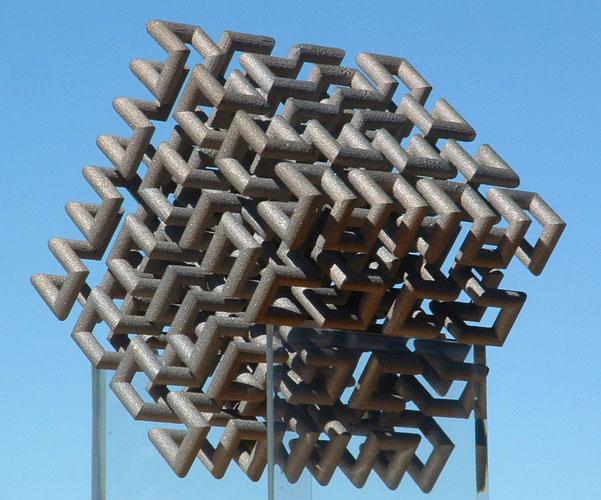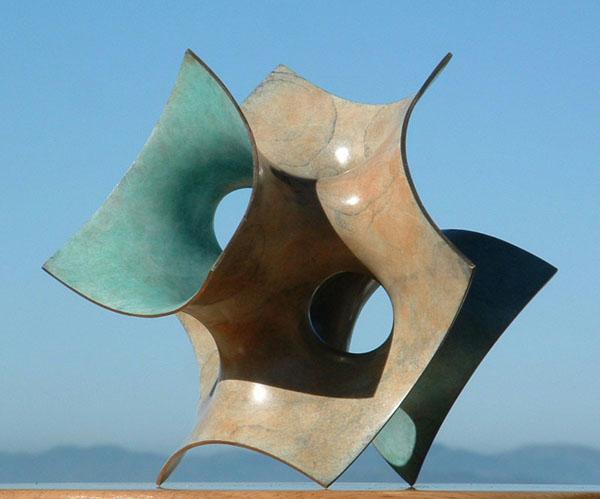Carlo Séquin
"Hilbert Cube"
Stainless steel and bronze alloy, 5 inch cube, 2005

"Hilbert Cube" is a space filling recursive curve in 3 dimensions in analogy to the famous
Hilbert curve in the plane.
Special care has been taken to never place more than three coplanar line segments in sequence.
At the largest recursion step the geometry has been slightly altered so as to obtain a closed loop.
"Genus-2 Costa Surface in a Cube"
Bronze cast with 2-color patina. 5 inch cube, 2005

In "Genus-2 Costa Surface in a Cube" twelve quarter-arc curve segments on the faces of a cube
form the three boundaries that suspend a minimal surface closely resembling the core section
of a genus-2 Costa surface.
Carlo H. Séquin is a professor of Computer
Science at the University of
California, Berkeley. He received his Ph.D degree in experimental
physics from the University of Basel, Switzerland in 1969. From 1970
till 1976 he worked at Bell Telephone Laboratories, Murray
Hill, N.J., on the design and investigation of Charge-Coupled Devices
for imaging and signal processing applications. In 1977 he joined the
faculty in the EECS Department at Berkeley, teaching courses in
integrated circuits, computer-aided design, and computer graphics. He
is a Fellow of the ACM, a Fellow of the IEEE, and has been elected to
the Swiss Academy of Engineering Sciences.
Séquin's work in computer graphics and in geometric design have also
provided a bridge to the world of art. In collaboration with a few
sculptors of abstract geometric art, in particular with Brent Collins,
Séquin has found a new interest and yet another domain where the use of
computer-aided tools can be explored and where new frontiers can be
opened through the use of such tools.
"Since high school I have been fascinated by geometry. I enjoyed
constructing the more complicated Platonic solids with ruler and
compasses, as well as reading about the 4th dimension. While at
Bell Labs in Murray Hill, I was introduced to the field of
Computer Graphics in courses given by Ken Knowlton and Lilian Schwartz.
In 1982, inspired by a talk by artist Frank
Smullin, I started to develop the Berkeley UniGrafix rendering system,
so that I could depict objects such as the "Skeleton of a Klein Bottle"
or the "Granny-Knot Lattice." Since then, the focus of my work has been
on computer-aided design (CAD). First I developed programs to support
circuit designers, later architects and mechanical engineers. In 1995,
I started a close collaboration with Brent Collins, who had
been sculpting abstract geometric art for two decades. With my
students, I developed a procedural "Sculpture Generator" program, to
help Collins prototype potential future work in virtual form. Later
programs generalized the original concepts, and eventually expanded the
design space through new paradigms. In this work I see myself as a
composer in the realm of pure geometry. The artistic achievement lies
in finding a procedural formulation that can reflect the inherent
symmetries and constructive elegance that seems to lie beneath the
physical laws of our universe."
Other artwork by Carlo Séquin may be seen at:
http://www.cs.berkeley.edu/~sequin/SCULPTS/sequin

